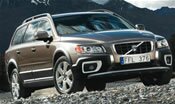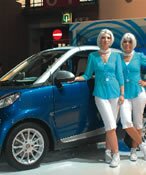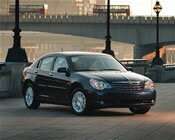Inflight Magazine of Brussels Airlines
Welcome to the Inflight Magazine of Brussels Airlines
In gear
Text Ted Macauley, James Kevin Mac Goris
Buckle up for a test drive and keep up to speed with the latest motoring news
 Unsung hero
Unsung hero
Meet the man whose job it was to put the latest Volvo through its paces – test driver Hakan Mattsson
For a man whose merest error of judgment could cost his company millions of euros, Hakan Mattsson has a contented and confident smile. He’s one of the unsung heroes behind every Volvo sold – a test driver.
Mattsson insists his happiness stems from his ‘dream job’. This is an occupation that takes him across the world. In 2007, for example, when setting up the new Volvo XC70, he trekked the globe testing the ‘mule’ car – a test-bed motor.
He and his crew went to Arizona to note how the XC70 would withstand constant and sweltering 45°C heat. They then flew to Colorado to test the engine and gearbox at altitude. After that, it was off to Spain for rough-terrain tests, followed by north Sweden to run the car in -39°C of snow and ice. But despite the travelling involved, Mattsson insists the job is no holiday. “There’s a lot of responsibility on my shoulders,” he says.
Mattsson has been a Volvo test driver since 1993. “The thoroughness of our checks and tests is phenomenal and as complete as we can make them,” he says. However long and arduous a test drive, Mattsson daren’t even listen to a CD because he needs all his senses to be sharp. “Even the slightest noise could be giving me a clue that something’s not quite right,” he says. “I need to consider everything as important feedback.
“There’s nobody to double-check me. The company must trust me and rely upon my findings and feelings. If I fail to spot something wrong, it could cost millions in terms of cars being recalled. I have a big influence on how a Volvo will end up in the showrooms,” he adds, smiling.
 Ferrari moves into A1GP
Ferrari moves into A1GP
Italian motoring giant announces a six-year link-up with the series known as the ‘World Cup of Motorsport’
Formula One champion Ferrari has joined forces with A1GP. The winner of the 2007 F1 drivers’ and constructors’ titles has signed a six-year deal to provide engines and chassis for the spectacularly hard-fought wintertime series.
Tony Teixeira, the Portuguese-born South African supremo of A1GP, seems overjoyed by the landmark partnership. “This deal should put an end to any speculation and doubt about our championship,” he said, ahead of this month’s New Zealand round. “We’re sick and tired of people telling us we’re not going to be around for much longer.
“This arrangement blows all that nonsense aside. It shows real commitment when a company like Ferrari is prepared to go along with us. It knows that there is massive potential in the A1GP series, and that’s why it has come in.
“The engines, which will be ready for the 2008/09 season, will be 100% Ferrari. We have more than 350 mechanics and engineers inside A1 workshops who’ll be putting the new cars, loosely based on the Ferrari F1 theme, together.”
 Renault brings the fun
Renault brings the fun
Prepare yourself for more distinctive offerings with a certain je ne sais quoi
Renault, which in the past has ventured into offbeat territory with cars such as the Vel Satis and Avantime, is now in fun mode. The French va-va-voomer has promised a rush of new models to excite those of us who consider cars more of a frolic than a necessity.
“We’re going to be in segments we’re not in at the moment,” Renault design chief Patrick le Quément revealed recently. “We’re aiming to produce vehicles that are more fun, lively and sporting. But I guarantee you’ll be able to recognise all our new models as Renaults.”
If the mighty midget Clio Renaultsport 197 is anything to go by, we’re in for a really hot time.
January dates 20 – A1GP, Taupo, New Zealand
In the news
 Get the show on the road
Get the show on the road
More than 700,000 visitors are expected at the European Motor Show Brussels 2008, which opens its doors to the public on Thursday January 17 for 10 days. Europe’s first automotive show of the year will feature motorcycles as well as cars, and the introduction of many exciting new models will be one of the big draws. The show will take place at Brussels Expo (Heysel), and tickets cost €12.50 for adults and €6.25 for children aged between six and 12. Children under six are admitted free.
TEST DRIVE
Chrysler Sebring
Family cars are rarely chosen for their looks – dull and boring tends to be the norm in this most competitive of sectors. But the new Chrysler Sebring is trying to break the mould. James Kevin Mac Goris takes a look behind the façade
 Strangely enough, considering that even Chrysler says of its new car ‘You either like it or you don’t’, I found that once I got past the Sebring’s aggressive, in-your-face styling, it grew on me slowly rather than blowing me away. But there’s no denying that the Sebring stands out in a car park. Dramatic and highly styled, its design is derived partially from the rakish Crossfire, and partially from the refined Airflite concept car Chrysler unveiled at Geneva in 2003. Neat touches include a trademark ribbed bonnet, egg-crate grille and big 18-inch alloy wheels. Inside, there’s a simple dashboard design, with instruments housed in a trio of attractive binnacles.
Strangely enough, considering that even Chrysler says of its new car ‘You either like it or you don’t’, I found that once I got past the Sebring’s aggressive, in-your-face styling, it grew on me slowly rather than blowing me away. But there’s no denying that the Sebring stands out in a car park. Dramatic and highly styled, its design is derived partially from the rakish Crossfire, and partially from the refined Airflite concept car Chrysler unveiled at Geneva in 2003. Neat touches include a trademark ribbed bonnet, egg-crate grille and big 18-inch alloy wheels. Inside, there’s a simple dashboard design, with instruments housed in a trio of attractive binnacles.
Elsewhere in the sector, competition such as Ford’s Mondeo has raised the bar in terms of quality and practicality, but Chrysler is keen to stress that their saloon isn’t a direct rival for the all-conquering Ford. Instead, the brand is pitching its new model as a more distinctive alternative to a Toyota Avensis or Honda Accord. Interestingly, in the US the car is perceived as having a very European style, whereas for European buyers this car is definitely all-American – not only in its looks but also in its behaviour.
Behind the wheel it’s immediately clear that, in the Limited version, the specs that come as standard are really quite high. The leather-rimmed, electrically powered driver’s seat is comfortable and this, plus the adjustable steering wheel, makes it easy to find a good driving position. The forward console is a nice derivation of the Chrysler winged motif, and chrome and tortoiseshell trim abounds.
 As a family car it’s very comfortable – my kids certainly found it so, begging me to drive them right up to the school gates for the first time in a while. No doubt they were impressed by the exotic styling. On the road, the Sebring performs well at high speeds, but around town one is left in no doubt that this is an American car – while the suspension is firm, the car has more roll than its European counterparts.
As a family car it’s very comfortable – my kids certainly found it so, begging me to drive them right up to the school gates for the first time in a while. No doubt they were impressed by the exotic styling. On the road, the Sebring performs well at high speeds, but around town one is left in no doubt that this is an American car – while the suspension is firm, the car has more roll than its European counterparts.
Most buyers will opt for the 138bhp
2.0-litre diesel, and rightly so – the fuel efficiency is excellent at around 6.7l/100km. This is in fact a Volkswagen engine, staple diesel in the Passat. Being a diesel, it is of course noisier, but what is interesting about driving the Sebring is that, apart from the diesel thrum, when the doors are closed one feels quite isolated from outside noise, even at speed on the motorway.
All in all, the Sebring is Chrysler’s determined attempt at doing things differently – an approach that worked very well with the 300. And considering that the marque’s current penetration in this sector in Europe isn’t very high, it’s probably as good a strategy as any to break into a hard market.
Leave a Reply
